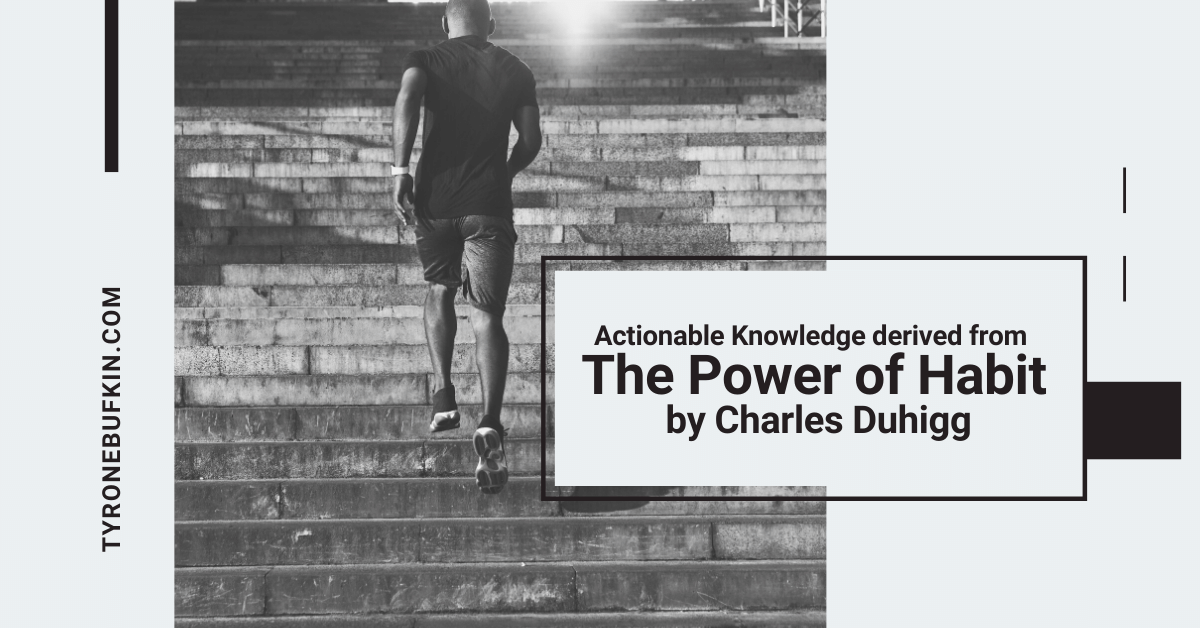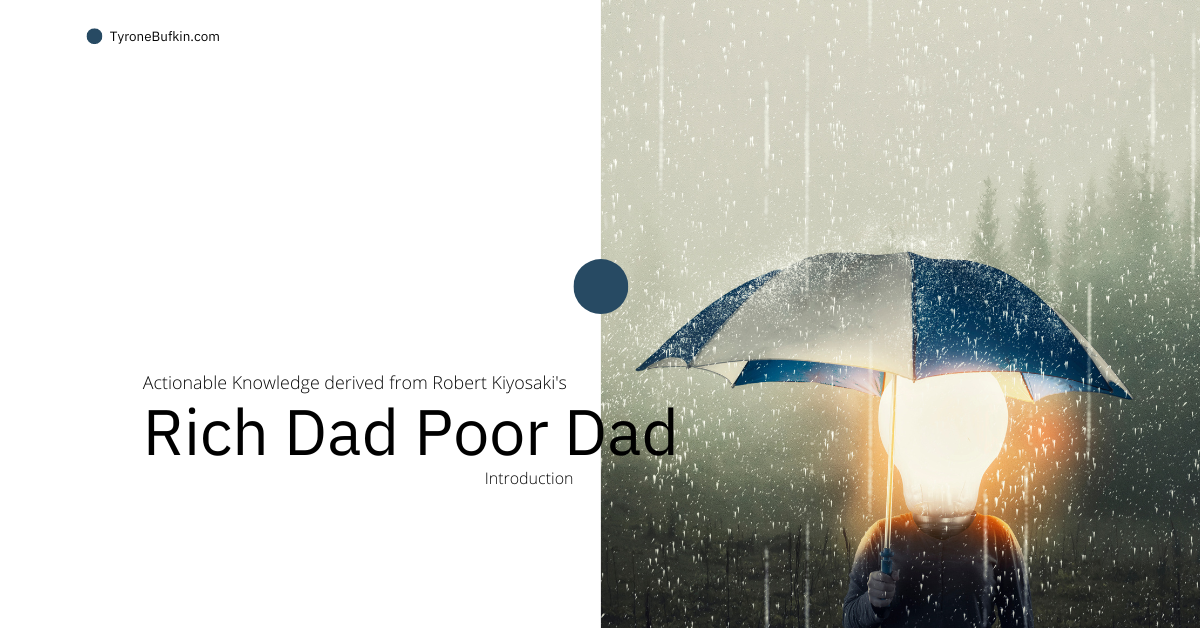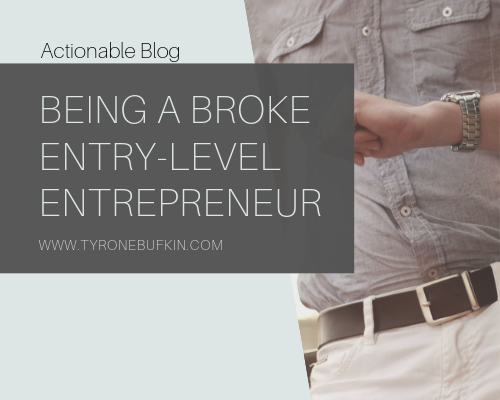THE FIDUCIARY ACTIONABLE KNOWLEDGE IN THIS POST MAY CONTAIN AFFILIATE LINKS. WE GET A COMMISSION, AT NO COST TO YOU, IF YOU DECIDE TO CLICK THROUGH CERTAIN LINKS. WE ONLY RECOMMEND PRODUCTS OR ORGANIZATIONS THAT WE BELIEVE WILL PROVIDE YOU WITH REAL RESULTS. THE INFOMATION IN THIS POST MAY HAVE BE DERIVED FROM THE SOURCES FOUND IN THE 'WORKS CITED' SECTION AT THE BOTTOM OF THE PAGE. PLEASE READ OUR DISCLOSURE PAGE FOR MORE INFO.
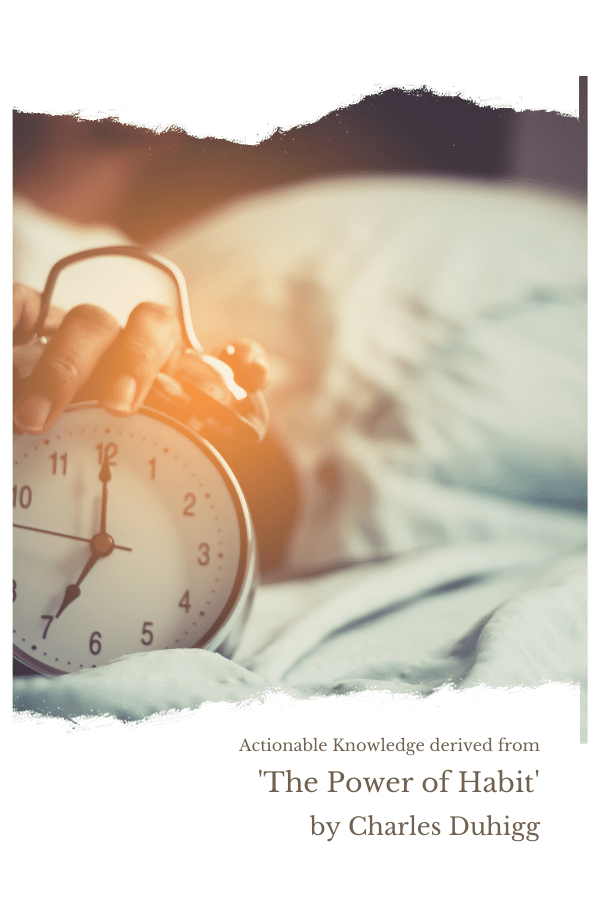
Once you know that bad or even dangerous habits exist and you understand that habits can be rebuilt, you have the freedom and a responsibility to remake them. The more you know about habits the more the power of habits becomes easier to grasp leaving you with the only option; to get to work.
I know you are just as busy as I am so I've organized the information derived from The Power of Habit by Charles Duhigg into three sections; The outcome and actions to achieve it, A condensed chapter by chapter summary, and finally my full summary.
Outcome: Created new or changed existing individual's and organization's habits
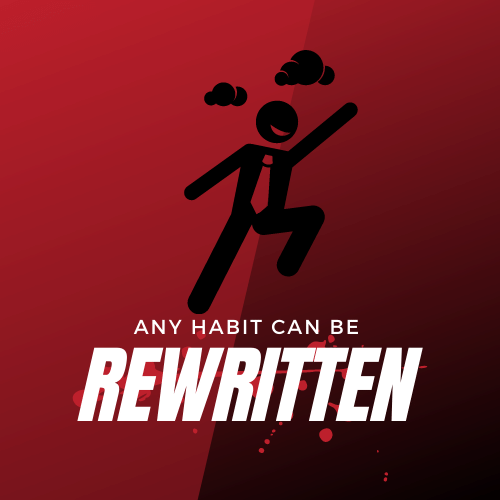
List of Action Items
- Identify and focus on one keystone habit that is familiar to the targeted habit.
- Detail every aspect of the routine.
- Define the actual reward you are craving.
- Isolate the cue(s) that trigger the habit loop.
- Understand the current limits of willpower.
- Ultize, or create the perception of, a crisis to disrupt more stubborn habits.
- Take responsibility and plan quick recoveries for inevitable relapses.
- Follow a plan to change the routine, overwrite the cues &/or disrupt the reward.
- Detail your progress and celebrate small wins.
- Create a movement using weak ties, strong ties, and self-empowering leadership.
The habit loop consists of a cue, routine, and reward. A sensitive cue triggers a familiar spike of activity in your brain; your brain makes a decision to start a routine and which routine to start. During the routine, your brain diverts activity elsewhere and goes into an automatic mode. Once the routine has concluded you will receive a physical and/or emotional reward and your brain fires up again with activity determining if this loop is worth remembering (Chapter One).
The defining factor to creating a lasting habit is to complete a habit loop so many times that the cue creates such a strong craving for the reward that it is almost impossible to be distracted from completing the routine. Cravings are what drive habits and make creating a new habit easier (Chapter Two).
The golden rule of habit change is to keep old cue(s) and reward(s) the same but shift or change the routine (Chapter Three)
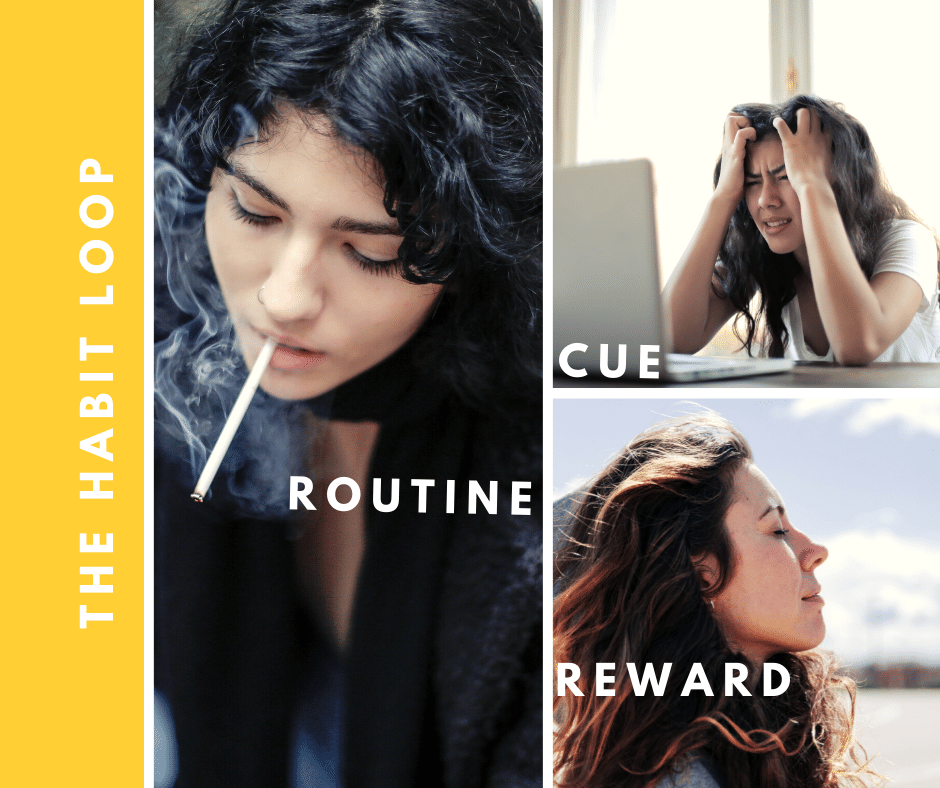
To create or adjust the culture within an organization it is important to establish, or understand the existing, keystone habits; Keystone habits cause a chain reaction of related habits. It can be difficult to identify a keystone habit, first, analyze the outcome you are looking for then detect the smallest wins that everything is built on (Chapter Four).
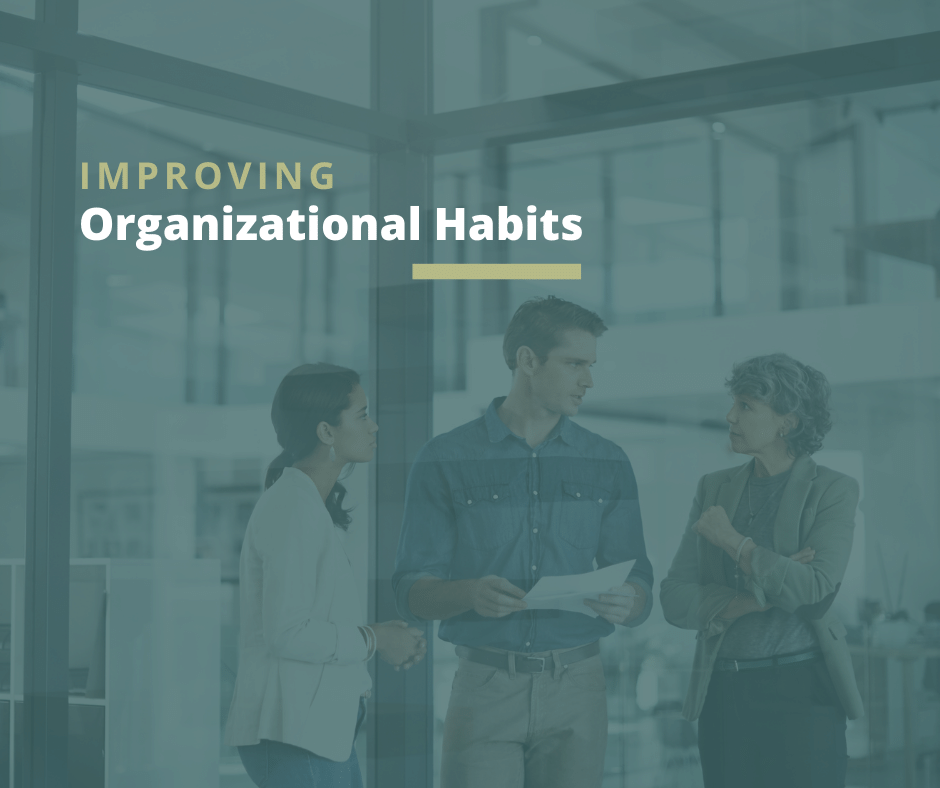
Starbucks, and similar companies, create employee training programs using willpower experiments that focus on automating and strengthening willpower allowing entry-level employees to consistently sell their higher-priced products. The employees learn to understand the limits of their willpower and follow preplanned strategies to strengthen willpower like a muscle and maintain a sense of control over their lives (Chapter Five).
Good leaders never waste the power of a crisis rather they use it to create habits through design rather than thoughtlessly by thousands of individual decisions. There are no organizations without operational habits. If these habits are forged correctly they will create necessary truces among employees allowing the organization to operate smoothly. However, alongside well-balanced truces, there must be one clear priority the supersedes any truce in order to protect the company from internal sabotage. Moments of Crisis, or the perception of crisis, give everyone the flexibility to change dysfunctional organizational habits. (Chapter Six).
Big companies use data collection to predict (and manipulate) consumer habits but because it is unsettling to the majority of consumers they have learned to disguise just how much personal information they have by placing products targeted at the individual next to familiar products. Folding in a new habit with a familiar habit makes forming the new habit easier (Chapter Seven).
The success behind the Saddleback Church, the Montgomery bus boycott, and any movement is the combination of the strong ties of friendship, the social peer pressure of weak ties that hold communities together, and leadership that gives the movement direction and the participants ownership (Chapter Eight).

Due to the neurology of free will, we are responsible for our habits if we are aware of their existence and negative effect. A pathological gambler should be held responsible for their debt, but a person, while suffering from sleep terrors, who murdered their spouse should not be. Once you know a habit exists, you have the responsibility to change it (Chapter Nine).
Knowing you need to change your habits so that you may lose weight, quit smoking, stop procrastinating often isn't enough; sometimes it takes something external to take the first step. Taking the rest of the steps of habit change requires detailing your progress, celebrating small wins, and planning for relapses their quick recovery (Afterward).
A reader's guide to using these ideas as a framework to understand and change a habit is to identify every aspect of the routine, experiment with rewards that satisfy the habit loop, isolate the cue using the location, time, emotional state, other people, and immediately preceding action (Appendix).
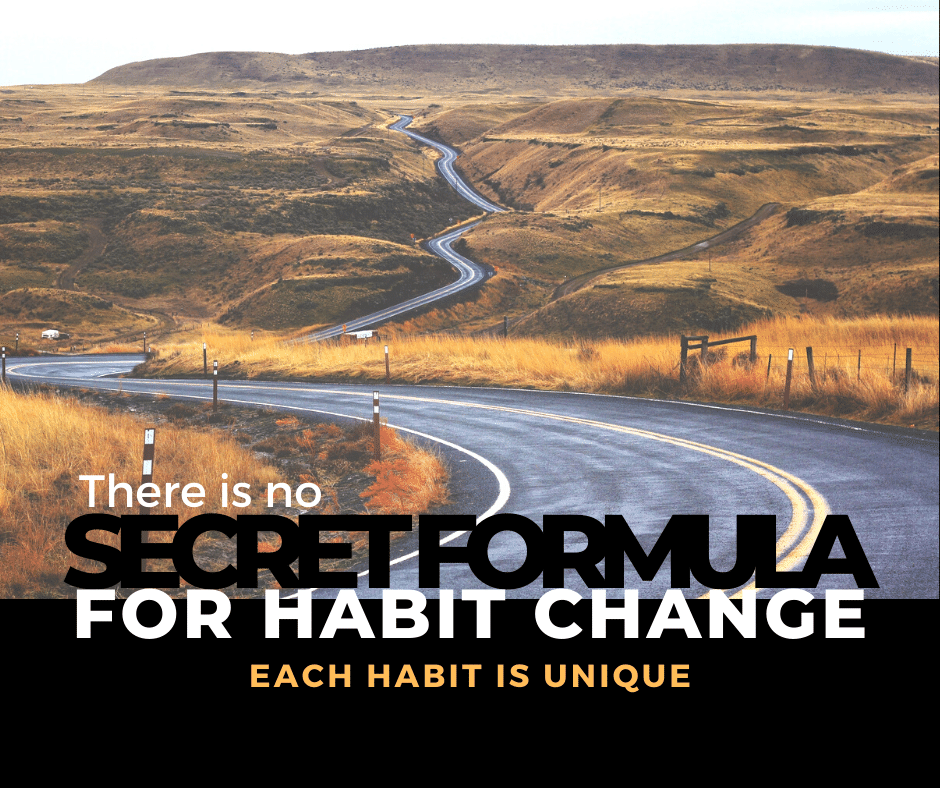
The bad habit I decided to use this book to break was my tunnel vision habit. I often make the mistake of focusing on one goal and ignoring several others; even if it is not the important result. The most demanding cue for this habit is an approaching deadline and the reward I crave is the satisfaction of completing something before its deadline. Using the golden rule of habit change, I decided to shift my routine to include splitting my focus over multiple goals each week. The keystone habit of frequently checking my schedule for upcoming due dates can still be effective as long as I schedule each activity when I have the most willpower to stay focused. It is more than possible to put my health, relationships, businesses, and those who depend on me at risk which I hope to be enough of a crisis to make my habit change more malleable. I've started to collect data in order to best understand this habit and make the necessary changes. In an effort to strengthen my resolve, I will make my habit change attempts public knowledge among the strong ties of my friends and the weak ties of my blog readers.
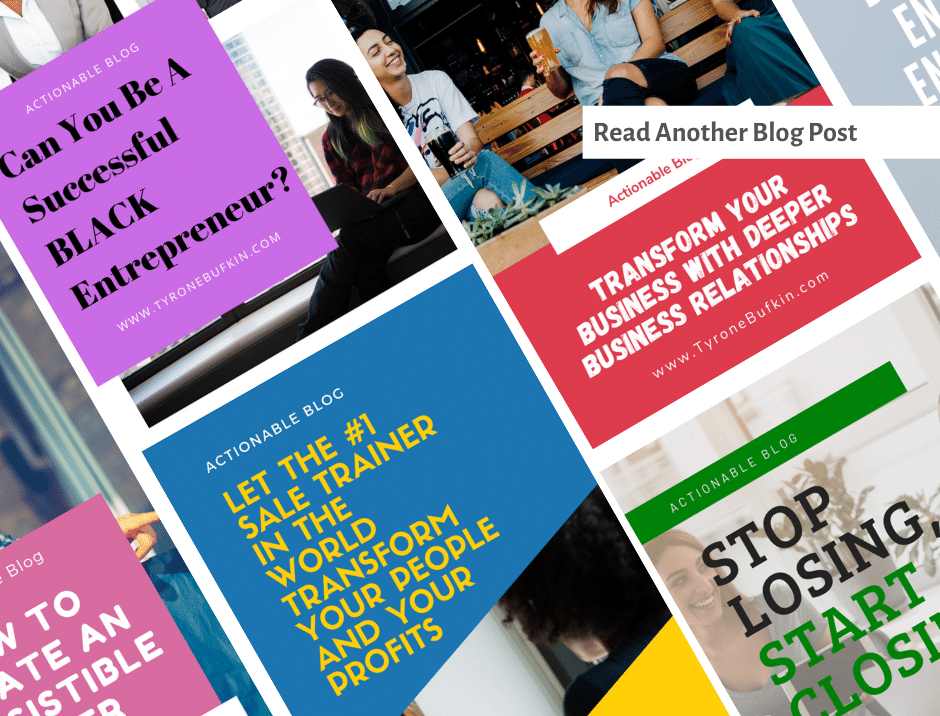
Reviewing this book has made me believe that even the longest and most ingrained results can be altered or broken. This means that even the most dysfunctional organization can be set right and anyone can sharpen their entrepreneurial skills. I hope my summary can help you and your organization succeed but I encourage you to read this book for yourself. If you are interested in a more detailed summary of each chapter please continue reading.
Chapter One
- Eugene "EP" Pauly was a severe memory loss patient, medical case study subject in 1992, and a patient of Squire. He had no short-term memory and damage to his hippocampi. Eugene lived at home with his wife Beverly Pauly, could steer lengthy conversations to a topic he was comfortable with, and to the casual observer would appear fine. He couldn't draw a map of his house but could walk to the bathroom, kitchen, and even around his neighborhood without hesitation or getting lost. Larry R. Squire, Ph.D. was the leading investigator of the neurological bases of memory and Eugene's doctor.
- Squire was convinced Eugune was forming new habits, so he gave him a classic memory test of sixteen different objects and glued them to cardboard rectangles. Then divided into eight pairs, choice A and choice B. One of the choices had the sticker correct on the bottom. Most people and monkeys can memorize which item is correct after a couple of rounds. Over time, Eugene couldn't remember playing the game ever all but his performance improved. After 28 days Eugene starting choosing the correct item 85% of the time, at 36 days he was right 95% of the time, but he couldn't understand why he was successful. Eugene had developed a new habit; The cue was placing the choices in front of Eugene and the reward was turning the choice over to see the correct sticker. To test this theory, the researchers undivided the sixteen objects and asked Eugene to separate the objects back into their eight pairs but he couldn't do it. This explained why Eugene was able to go to the bathroom, make food in the kitchen, or take a walk around the neighborhood. This experiment also revealed that habits are surprisingly delicate because if there were even a slight change in Eugene's cues then he could not complete the routine.
- Henry "HM" Molaison, an earlier patient of Squire, suffered from epilepsy and massive seizures and in an attempt to cure it had a bilateral medial temporal lobectomy to surgically resect the anterior two-thirds of his hippocampi and some surrounding tissue. After the surgery, he lost the ability to retain new information for more than 20 seconds or so. HM was hospitalized for the rest of his life and unable to hold conversations.
- In the 1990s, scientists experimented on rats to determine if the basal ganglia played a part in memory. The first few times a rat explored the maze their brain lit up with activity, but the more the rat memorized the maze the brain activity decreased but the basal ganglia seemed to take over. The basal ganglia seemed to store habits. Brain activity spiked at the beginning of the maze when it hears a click and again at the end of the maze when it gets the chocolate, these spikes are the brain determining when to cede control and to which habit.
- Ann Martin Graybiel, a brain researcher who oversaw many of the basal ganglia experiments, trained rats to run down a maze until a habit was formed and then extinguished the habit by changing the placement of the reward. However, replacing the reward back in its original place and the old habit reemerged right away. Habits didn't seem to go away.
A habit consists of a cue, routine, and reward. When a habit emerges, the brain stops fully participating in decision making or diverts focus to another task unless you deliberately fight the habit and find a new cue, routine, or reward. A cue can be almost any visual, location, time of day, emotion, sequence of thoughts, company of people, or any combination of things. The routine, which can be a physical, mental, or emotional activity, can be extremely complex or remarkably simple. The brain can't tell the difference between a good or bad habit. Once we develop a habit loop it stays in our brain but it can be diverted or overrun.
Dr. Squire's memory loss patient Eugene had no short-term memory but was able to develop powerful new habits over time; without even realizing it. However, while his habits allowed him to freely move around his house and his neighborhood, they were extremely sensitive to change.
Researchers have seen many echoes of Squire's discoveries with Eugene. Habits shape our lives because they are so powerful that they can cause our brain to cling to them at the exclusion of common sense and can be triggered without us knowing, but delicate enough that, if we know and change the cues and rewards, we can disrupt it. Habits can often be formed outside our consciousness and permission or be deliberately designed and reshaped.
If you want to develop profitable habits, the first step is to figure out the individual parts of a habit. You will be unable to stop a bad habit or start a good one if you have no idea cues that trigger it or the reward you receive for its completion.
I have a lot of personal and business results to achieve but I have a bad habit of focusing on one result and losing momentum in others. In order for me to succeed, I create a week-by-week schedule that balances my focus over multiple results. I identified that the most powerful cue that triggers my tunnel vision is imminent deadlines and the reward is the feeling of preparedness and completion. With this information, I can figure out how to create a plan to overcome this bad habit.
Chapter Two
In the early 1900s, even though hardly anyone brushed their teeth, Hopkins reluctantly was hired and created a national craving for Pepsodent. Hopkins marketed Pepsodent as the solution to the film on your teeth. "Just run your tongue across your teeth, you feel a film that makes your teeth look off-colored and invites delay" One of his ads exclaimed. Hopkins found a cue, the film on your teeth, and triggered it. " Look how pretty people's teeth are after using Pepsodent daily" another ad boasted; This was the clearly defined reward. Before Pepsodent only 7% of Americans had a tube of toothpaste in their cabinet, a decade after the Hopkins ad went national wide that number grew to over 65%.
- Early in the 1990s, Claude C Hopkins, the prominent American advertising executive behind the success of huge products such as Quaker oats, was approached to market a new toothpaste product called Pepsodent.
- By 1996, Procter & Gamble was one of the largest consumer goods firms on earth behind the success of Pringles, Oil of Olay, Bounty Paper Towels, CoverGirl Cosmetics, Dawn, Downey, and Duracell. P&G collected more consumer data than almost any other merchant on earth and relied on complex statistical methods to craft their marketing campaigns.
- Drake Stimson was the head of the marketing team for a promising new product called Febreze created three years and millions of dollars earlier.
- In the 1980s, Wolfram Schultz was a part of a group of neuroscientists at the University of Cambridge studying the brains of monkeys, including a monkey named Julio, as they learned to perform simple tasks to figure out which parts of the brain were responsible for new actions.
Studies, based on Hopkins two rules, show that people who have successfully started new exercise routines & diets were more likely to stick to it if they chose a specific and predetermined cue, such as running as soon as they got home from work, and a simple reward such as a beer or guilt-free tv watching.
In 1996, a Procter and Gamble team tried using Hopkins's two rules to sell a new product called Febreze in a category that did not exist. Stimson's team found, in a phoenix, test market, a 20-year-old female park ranger who caught wild aminals including a lot of skunks that smell up her person, clothes, car, and house; Her dating life was always disrupted. She was overjoyed using Febreze because it completely removed the bad smell. From this, Stimson's team aired a marketing campaign with the sense of relief that the park ranger felt; The cue being a bad smell and the reward being odor being eliminated. Sales started small and got smaller; People bought one bottle used it for a while, and then forgot about it. Febreze was failing because the cue, a bad smell, was not detected by the people who needed the product most.
Schultz began experiments on Julio, who had a very thin electrode inserted into his brain, to figure out how rewards work on a neurochemical level. Julio's job was to touch a level whenever colored shapes appeared on the screen in front of him. If he touched the level when a shape appeared he would get a drop of blackberry juice; Julio liked blackberry juice. Again and again, Whenever Julio received his reward his brain activity would spike suggesting he was experiencing happiness, but as the experiment continued Julio's brain began to spike the instant he saw the shapes on the screen before the juice had arrived. The shapes had become a cue not just for pulling the level but for a pleasure response. Schultz adjusted the experiment by refusing, delaying, or watering down the juice; this made Julio angry or sad. A new pattern emerged; The juice cued anticipation of joy but when the juice didn't arrive that joy became a craving that if unsatisfied lead to angry or depression. In similar experiments, after the monkey correctly pushed the lever researchers would try to distract the monkeys with food or the ability to go outside and play. For the monkeys who had not developed a strong habit, these distractions would work. However, once the monkey's brain had begun to anticipate and crave the juice no distraction could pull the monkey from the screen like a gambler staring at slots. The cue and the reward were not enough to sustain the habit, only when the brain starts craving the reward will the habit last. Using this new information, Stimson's team added a good smell to Febreze, re-targeted the cue of cleaning your house, which most people do regularly, and re-branded Febreze as the reward for cleaning; sales double immediately. Turns out Hopkins's success wasn't as simple as he thought, studies showed that people were craving that tingling cool minty taste that toothpaste gives you after your brush.
As an entrepreneur, If you can use cues that develop a craving within your clients then your products can become a daily habit; imagine what that would do for your profits. However, in order to develop that craving, it is vital for your clients to have a powerful cue and an unforgettable reward.
As for my tunnel vision issue, I know how a craving feels when I am approaching a deadline. Perhaps I can figure out a way to develop a craving to achieve each of the previously set results for the week. I imagine my reward would be achieving multiple big-picture results well before their deadlines instead of just one.
Chapter Three
- As football coach to the Tampa Bay Buccaneers, Tony Dungy decided to focus on changing players' old habits, specifically only the routine.
- The co-founder of Achocolic Anonymous, Bill Wilson
- In the summer of 2006, a 24-year-old graduate student named Mandy sault help with her chronic nail-biting habit at the counseling center at Mississippi State University.
- Habit Reversal Training is a psychological treatment used by psychologist Brad Dufrene while treating Mandy
As Dungy uncovered, to change a bad habit you must keep the old cue and the old reward but shift the routine. He drilled the Buccaneers with fewer plays than any other team in the league and focused his team on reading the familiar cues of the other team and acting immediately on them without thinking which would make them faster and more successful during each play and receive the familiar reward that accompanies a winning play and game.
The AA sidesteps the psychology, scientific, and biochemical issue that research says is at the core of why alcoholics drink but instead provides a method for changing the habits that surround alcohol abuse. Wilson based the reasoning for the twelve steps on the fact that there were twelve apostles. He developed strategies seemly at random such as participates must 90 meetings in 90 days or the participates focus on spirituality with seven of the twelve steps. Meetings do not have a curriculum or schedule but begin with a member telling his or her story after which others can chime in. There are no professionals that guide conversations and few rules outlining how meetings are supposed to go. Researchers would eventually find some similarities in the AA method to those Dungy used on the football field. AA successes because it allows the members to keep the same cues and rewards but shifts the routine.
The first step in Habit reversal Training is called Awareness Training and is used to figure out the cues to a habit prompting Dufrene to ask Mandy "What do you feel right before you bring your hand to your mouth to bite your nails?". The next step was to ask Mandy why she bit her nails, for Mandy it was because she was bored. Mandy was given homework to notate each time she felt the cue to bite her nails. Then the therapist taught Mandy a Competing Response, whenever she felt the cue she needed to do something with her hands that made it impossible to put her fingers in her mouth and search for something that would provide physical stimulation. The cues and rewards stayed the same but only the routine was changed.
Studies have shown that most of the time you can change any habit, including smoking, bed-wetting, nail-biting, and snacking, once you truly understand the cues and rewards of the routine. Some habits however require one more element; belief.
Knowing that your clients, and potential clients, already have regular habits, all you need to do is make your product or service a part of an existing routine. If your client already reads blogs, figure out how to add your blog to their routine. If your clients have shopping habits, how do you get your store on their frequent favorites?
Since I identified the cue and reward of my tunnel vision, I want to use the golden rule of habit change to shift the routine. I decided to create my own weekly deadline for a manageable number of results all of which can easily be done within the week. The cue and reward would stay the same but I would be achieving multiple results ahead of their actual deadline.
Chapter Four
When O'Neil became CEO of Alcoa he focused on worker safety instead of boosting profits and lowering cost. Workplace safety would be the indicator of the success of the company. Within a year the companies profits grew 5 times larger. O'Neil targeted one habit, safety, in order to change all the other habits that were affected by it. These underline habits are known as Keystone habits.
- Alcoa Aluminum Corporation was a world leader in manufacturing and supplying all kinds of metals.
- After a steady decline, Alcoa's board hired a former government bureaucrat as the new CEO, Paul O'Neil.
- Michael Phillps is an Olympic swimmer with a very precise training routine used originally to calm down before races.
- Bob Bowman was Phillips' coach who taught him the training habits.
While working as a government bureaucrat, O'Neil would study organizational habits and routines finding that teams with positive keystone habits would excel such as when the NASA team would applaud and cheer every time a project succeeded or failed rejoicing in the fact that the attempt was made. Similarly, most people who campaigned for an office would attach their campaign to the building of something, such as a hospital, regardless of if there was a need for it; they would wonder why it didn't always work.
O'Neal's plans to drastically improve Alca's safety record, which few managers or employees could argue with him on, began with understanding why injuries were happening in the first place. To understand why injuries were happening, you have to study how the manufacturing process was going wrong. To understand how things were going wrong, you have to educate the workers about quality control and efficient work processes which makes it easier to do everything correctly and safely. His plan was based on a simple habit loop; any employee is involved in a workplace injury or has an idea to prevent injury (cue), the injury report or idea is summed up in a new safety policy by floor managers and given to the vice president then to O'Neiln within 24 hours (Routine), promoting the people who followed the system (Reward). In order for O'Neal's safety plan to happen, each unit had to build a streamlined communication method for executives, better processes with fewer errors, and higher quality machinery which increased profits and lowered cost.
While is it difficult, You can detect keystone habits by searching out certain characteristics in small wins that trigger widespread change such as exercising at least once a week, eating together as a family, making your bed, or the library of congress reclassification of homosexuality.
Phillips's routine, which included visualizing and memorizing every second of the race, was filled with so many little wins that winning the races was so automatic we won a race blinded with water in his goggles.
In an effort to decrease the number of infant deaths the government officiants working with O'Neal discovered that the pregnant mothers were malnourished, had poor eating habits even before they became sexually active, and their high school teachers were never taught or understood the importance of nutrition in college. Improving college curriculums was the keystone habit to lower infant deaths.
Keystone habits make hard choices easier because everyone understands the culture of the keystone habits and thus any violation is not acceptable.
Developing keystone habits within your company makes the hard choices easy. If everyone in your organization understands the culture of the keystone habits they will know that any deviation or violation of the culture will not be tolerated.
To apply this to my multi result weekly goal, I identified a keystone habit of reviewing and updating my schedule first thing in the morning. By looking at my weekly goals every day I will know what I need to work on for that day in order to make progress.
Chapter Five
- In a popular 1960s Stanford experiment on willpower, 4-year-olds were giving one sweet treat which they could eat immediately, or if they could wait they would be given two treats. Only 30% of the kids managed to ignore their temptations long enough to earn the second sweet treat. Years later the kids who waited for two treats had higher grades and test scores, were more popular, and took fewer drugs.
- A 1980 experiment at Case Western Reserve University placed freshly baked cookies next to a bowl of rashes in front of participants; half were told they could eat the cookies and ignore the rashes, and the other half were told to do the opposite. The rashes eaters used a lot of self-discipline to ignore the cookies but the cookie eaters didn't need to use any. Next, the experimenter asks all the participates to attempt to complete an impossible puzzle but they were allowed to quit at any time. The rashes eater quit the puzzle 60% faster than the cookie eaters and were more frustrated and annoyed.
- In a 1992 willpower experiment, a British psychologist hoped to boost the willpower of stubborn elderly patients recovering from hip or knee replacements to habitually complete the required exercise routine immediately after surgery even though it was painful. After the surgery, The psychologist asked some patients to detail their exercise goals and compared their results three months later with patients who did not detail their exercise goals. The patient who detailed their exercise goals recovered three times faster than the patients who had not done so. Many of the plans were built around situations the patient predicted would be a deterrent to exercising. In fact, they identified cues to trigger their exercise routine.
- In 2006, Australian researchers Megan Oden & Kim Chang created individual two-month programs focused on exercise, finance, or academic discipline that successfully strengthened willpower in those activities but also created success in other areas of their lives.
- Mark Moravan, a Psychology expert, set up an experiment with under-graduates asking them to ignore warm cookies; half of the participants were treated kindly, informed of the importance of the experiment, and thanked for their participation while the other half were rudely told to follow the instructions. After 5 mins of ignoring the cookies, none gave into temptation, the researcher asked each participant to complete a boring puzzle that required a lot of focus. Students who had been treated kindly were able to maintain their focus on the puzzle but the others performed terribly and were unfocused. The researcher uncovered that the students who had been treated kindly had a sense of control during the experiment and thus were able to conserve their willpower.
In order to successfully sell a higher-priced cup of coffee, Starbucks researched and implemented employee training curriculums that focused on self-discipline and willpower that would transform a high school dropout who suffered from anger issues so severe that he was unable to keep employment into a successful Starbucks manager.
While the early experiments concluded that willpower was just a skill to be learned, the Case Western experiments proved that willpower is more like a muscle that gets tired the harder it works and according to Oden & Chang willpower is a muscle that can be self-regulated strengthened. Similarly, a child learning music or sports builds the willpower required to succeed in academics.
Starbucks' ongoing employee training is focused on building willpower and self-discipline into an organizational habit by training ahead of time how to respond to common cues like an angry customer, a customer in a hurry, or a regular customer who enjoys being known by name. The company gives the employees a great sense of control by asking them to decided for themselves how to greet customers or how to merchant the product in the store.
If you can find a way to strengthen your employee's willpower you would have a positive work environment, minimal operational problems, and happier clients.
Knowing that willpower is a muscle that gets tired, I need to schedule time for my results earlier in the day as I am likely to have more willpower. Once I begin to strengthen my willpower, I should be able to focus on my results throughout the entire day.
Chapter Six
There are no organizations without institutional habits, they are either deliberately designed or thoughtlessly formed with rivalries or fear. Sometimes even disruptive habits can be transformed by leaders who know how to seize the right opportunities; in the heat of a crisis, the right habits can emerge. It may seem like most organizations make a rational choice based on deliberate decision-making, but Nelson & Winter's research discovered that's not really how organizations operate at all. Instead, firms are guided by long-held organizational habits that emerge from thousands of employee's independent decisions. For example, a fashion business may think the reason they choose the color of the season came only from their research and development but in fact, their decision also included employee gossip, rival companies, and individual taste.
- Rhode Island Hospital was one of the nations leading medical institutions, the main teaching hospital for Brown University, and the only level one trauma center in southeastern New England. The hospital was overwhelmed with internal tension and disruptive organizational habits between the physicians and nurses; it was the source of many deadly mistakes. The national media attention pushed the hospital into crisis.
- Nelson & Winter researched for more than a decade concluding that almost all organizational behavior is best understood as a reflection of general habits and strategic orientations that come from an organization's past.
- The London Underground was governed by a balance of power between four divisions, civil, signal, electrical, and mechanical engineering, with thousands of strict but fair unwritten truces that discouraged all nineteen thousand employees from overstepping their boundaries or breaking unspoken rules. Each individual truce made it possible for trains every few minutes to transport thousands of passengers all day long but together caused the death of thirty-one people and injured dozens more in an avoidable fire. Ticketing clerks were strictly limited to selling tickets so investigating a burning tissue was overstepping their bounds. Station employees weren't trained how to use or even recognize the sprinkler system or extinguishers The safety inspector never saw a letter from the London Fire Brigade warning about fire risk because it was sent to the operations director. Employees were instructed only to contact the fire brigade as a last resort. The fire brigade insisted on using its own street-level hydrants instead of the pipes in the ticketing hall closer to the fire.
Without these unspoken organizational routines, a company's operations would be a disaster because they create truces and limits that protect the company from internal sabotage. A competitive company may allow employees to compete with each other for a contract but they would be disciplined if they negatively affect the reputation of the company just to beat another employee. This is why employee handbooks can't teach you how to survive or thrive inside an organization, you must learn the routines from several employees. These routines allow an organization to function most of the time, however, truces must be balanced or they will break under pressure. At Rhode Island Hospital the nurses held up a one-sided truce with the doctors, so at critical moments, such as when a surgeon was about to make a hasty mistake, the routines that would have prevented fatal accidents failed and patients died as a result. As we learned from the King's Cross preventable and tragic fire, even the most well-balanced truces can fracture if an organization does not also have one priority that overshadows everything else; during a crisis, an organization's habits become malleable enough to make the necessary habitual changes.
In a state of crisis, Rhode Island Hospital was able to convince stubborn doctors and frustrated nurses to go through an intensive behavioral correction training program that empowered the medical staff and redesigned the surgical safeguards because everyone became more open to change. Harvard University's teaching Hospitals amidst plans to close the hospitals convinced senior physicians to speak openly and in painstaking detail about their mistakes and near misses to hundreds of their peers every three months. After the tragedy of the space shuttle Challenger, NASA was able to overhaul how it enforced quality standards. After the blaze at King's Cross, public hearings were held for ninety-one days which lead to public protest forcing new leadership, new laws, and an overhaul of the Underground's truces added a transcendent focus on passenger safety. Good leaders seize crises to remake organizational habits. In fact, wise leaders seek out moments of crisis, or create the perception of crisis, in order to turn around dysfunctional organizational habits; Giving everyone the sense that something must change.
If you ever find yourself managing an organization with disruptive organizational habits, you can use the power of a crisis to get everyone to make a change for the better of the organization but would also improve the people in the organization personally.
There is a lot of people depending on me to accomplish different results, so the crisis I can bring to the foreground of my tunnel vision habit is that feeling of letting someone down. Not just because I was unable to come through for them but because I may have been able to come through with I wasn't so focused on something else. This is assuming I don't agree to more results than I am able to accomplish.
Chapter Seven
- Andrew Pole, a statistician, and data expert for Target was tasked with using consumer data from millions of shopper's loyalty cards, redeemed coupons, and credit cards to determine which customers are pregnant because wherever they purchase their bottles and the formula they'll buy everything else they need for years to come.
- The old-fashioned psychological retail tactics, elements of which are still used today, treat each shopper the same; Positioning produces in the front of the store so shoppers feel better about buying the unhealthy things later or putting the most profitable product on the right because most shoppers turn right after entering a store. Chains such as Target realized they need to appeal to customers' unique buying preferences in order to remain competitive.
- In 1984 Professor Alan Andreasen published a paper uncovering why some people suddenly change their shopping routines. After interviewing almost three hundred people over the phone Andreasen's team noticed that people who went through a recent life change, 10%-15%, switched brands in the previous six months. The biggest life change and vulnerability to marketing interventions were having a baby.
- In the summer of 2003, a promotion executive at Arista Records named Steve Bartels was certain this new song "Hey Ya!" was going to be a timeless hit based on his intuition and a predictive algorithm that compared listeners' habits with different factors of thousands of hits. But it was not initially popular because it did not sound like the other hit songs. The song became increasingly more popular when it was sandwiched between two familiar songs.
- In the early 1940s, the U.S. government was shipping much of the nation's domestic meat supply to support the troops fighting in World War II leaving the nation with fears of being starved of protein. For the solution, the government turned to the leading sociologists, psychologists, and anthropologists to convince Americans to eat unpopular but protein-rich organ meats such as livers, hearts, kidneys, brains, stomachs, and intestines. In order to change people's diet, they camouflaged the exotic with everyday garb; such as steak & kidney pie and meatloaf with liver mixed in. Even after the war, organ meat consumption rose and became integrated into the American diet.
Pole was able to determine which Target shoppers were pregnant even if they didn't disclose that information; He learned hiding what you know is sometimes as important as knowing it because shoppers were not happy to find out just how much Target knew about them. Target had to make the unfamiliar seem familiar by placing random products alongside the targeted pregnancy products; she would assume she was getting the same mailer as everyone else on her block. If you dress a new something in old habits, it's easier for the public to accept it. Personally, If you like to be social and you want to begin a new exercise routine then find a workout buddy; this would combine your unfamiliar exercise habit with your familiar social need.
The new habit I'm attempting to form is divesting my time each week onto multiple results as opposed to just one. Using the same methods as Target, I know to combine this new habit with a familiar habit I have of checking for upcoming deadlines. Reminding myself that I have multiple deadlines approaching will make it easier to avoid tunnel vision.
Chapter Eight
There are three parts of the social habits behind a movement; The strong ties of friendship, the weak ties that hold a community together, and leaders who give the movement's participants direction, a feeling of identity, and ownership. Rosa Parks was personally respected and embedded in dozens of social networks within her community spanning multiple social and economic hierarchies. Those strong ties created social peer pressure to the weak ties in the community. As Granovetter's research uncovered, news and pressure to join the boycott spread faster through influential weak ties. One of the critical reasons the movement endured violence and oppression for months because of King's consistent call for non-violence responses and conversion from participants to self-directing leaders.
As an entrepreneur, you can use the habits that fuel a movement to grow your organization. As the leader, you should direct and empower in all your strong ties, such as employees, repeat clients, and trusted partnerships, the responsibility to spread information to their weak ties that would promote your organization and provide sales leads and positive exposure.
In order to sustain my new muti-result habit, I must involve the strong ties of friendship, the weak ties of my circle of influence, and empower them to apply social peer pressure to keep me on track. So I make sure everyone knows the results I'm after by talking openly about them to people close to me and publicize them on my website.
- After a long workday Thursday, December 1, 1955, in Montgomery, Alabama Rosa Parks refused to give up her seat to a white man, was sent to jail, and the civil rights movement pivoted. That small refusal set into motion mass protest from the black community to boycott the city's buses until they were desegregated and introduced the world to a young leader named Martin Luther King, Jr. Rosa Park was not the first black passenger to be jailed for breaking the bus segregation law but she became the epicenter of the civil rights campaign because she triggered the right combination of social habits.
- In the late 1960s, a Harvard Ph.D. student named Mark Granovetter studied 282 men and found that assistance for their employment was only provided by friends and casual acquaintances (friends of friends) but was rejected assistance from strangers. These weak ties were more important than strong ties because they often gave access to unaccessible social networks beyond the one or two cliques of strong ties. Ignoring social obligations puts you at risk of losing your social standing (reputation) and benefits.
- A sociologist at the University of Arizona in the 1980s named Doug McAdam analyzed the accepted applicants and participates in the Mississippi Summer Project; A ten-week program devoted to registering black voters in the south. In the months leading up to the program, the violence, and threats of violence, caused a third of the applicants to stay home. According to McAdam's research, the participates showed up because of social pressures from close friends and their casual acquaintances expected them to.
- Rick Warren, a Baptist pastor, in the summer of 1979 set out to start a congregation for people who didn't already attend church by appealing to the social habits of groups of people rather than individuals. Thirty years later Saddleback Church is one of the largest in the world because Warren spoke the people's language to the giant crowds on the weekdays, signed people up for small groups that developed strong ties of friendship, and taught each parishioner new habits that self-propelled their faith life.
Chapter Nine
- Angie Bachmann decided to gamble occasionally but over time it turned into an uncontrollable habit that in about a year put her family into $20,000 of debt before she sought out help for the first time. The compulsion didn't go away, for years Bachman gambled away over $900,000 of her own money and $125,000 loaned by the casino. When the casino took her to court for a settlement, her lawyer argued that she shouldn't bear culpability because she gambled not by choice, but out of habit.
- Seven years after Backmann's trial, Brian Thomas killed his wife while still sleeping. Mark Mahowald, a professor of neurology at the University of Minnesota, said that the brain is capable of very complex activities, but when asleep nothing is guiding it except for your most basic habits because you are not capable of making choices. During sleep, the brain stem paralyzes our limbs and nervous system allowing our brains to experience dreams with our bodies moving; Sleepwalkers only go into incomplete paralysis as they sleep and their body remains active. Just like more than 150 murderers and rapists suffering from sleep terrors, Thomas was prosecuted for his wife's murder but was found not guilty.
- In 2010, cognitive neuroscientist Reza Habib discovered that pathological gamblers got just as excited about near misses as they did about wins; nonpathological gamblers viewed a near miss as a loss. Because of that difference, Habib hypothesizes this is why they gamble so much longer than everyone else.
Harrah's Entertainment relentlessly persuaded Angie Bachmann, a pathological gambler, to continue gambling long after she admitted to having a problem. Once she ran out of money, over $900,000, the casino loaned her $125,000 so she would continue gambling. In the eyes of the law, Brian Thomas was found not guilty of murdering his wife in the midst of night terrors but Bachmann is held responsible for her debt to the casino plus an additional $375,000. All habits are unique and complex but malleable if the person is conscious of is actively trying to change them. Both Bachman and Thomas acted uncontrollably out of habit but Thomas never knew the patterns that drove him to kill his wife and Bachman was aware of her habits. Once you know a habit exists, you have the responsibility to change it.
In your entrepreneurial journey, your bad habits will always affect the business. If you have a habit of showing up late, then your employees will assume being late is ok. If you have poor spending habits, your business bottom line will suffer. Again if you know that bad habits exist, it is your duty to figure out how to change them in a way that does not negatively impact your business.
So this information has affirmed my decision to disrupt my tunnel vision habit before it negatively impacts my businesses any further. I also need to take a look at my other habits to determine which of my other habits are holding my business back.
Afterward
Simply knowing you need to change often isn't enough, sometimes it takes something else such as exposure to the right idea, resonating story, or encouragement that makes the first step feel within reach. In order to break an old habit, you need to measure small wins along the process. Weighing yourself daily while dieting and exercising can encourage you to continue your momentum. No matter how strong our willpower is we are guaranteed to fall back into our old ways once in a while. Planning for small relapses will make it easier to get back on track. Habits emerge when patterns are predictable and our brains learn to crave a specific reward at a specific moment but when rewards defy prediction it is harder for the habit loop to start. Studies suggest that the process of experimentation and failure is critical in long-term habit change; smokers often quit and then start smoking again as many as seven times before up cigarettes for good. During relapses, they begin to achieve self-awareness about the cues and rewards that drive the patterns. Failure forces us to learn, even if we don't want to. Most procrastination solutions ask people to pay close attention to how and when their willpower fails and accommodate the impulse to procrastinate rather than ignore it. If you plan for failure and then plan for recovery, you're more likely to snap back faster. Every habit abides by a set of rules, and when you understand those codes you gain influence over them. any habit can be changed.
Every entrepreneur should already have a habit of keeping track of your activities especially if it concerns finances, clients, employees, or anything else that impacts the business. You can use good record keeping to protect your company from false claims, pinpoint areas of improvement, and maintain steady growth.
Appendix
There isn't one secret formula for quickly changing any habit, there are thousands because individuals and habits are so different. This book is a framework for understanding how habits work and how they might change; Identify the routine, experiment with rewards, isolate the cue, and have a plan. With most habits, the routine is the most obvious aspect of the habit loop and should be defined in great detail. Identifying the reward requires written observation and experimentation to be certain. Try changing one thing at a time and use 15-minute intervals to confirm that the urge has been satisfied. Almost all habitual cues fit into one of five categories; location, time, emotional state, other people, and immediately preceding action. Lastly, you can use all the data you collected to change the habit keeping in mind that some habits are harder to understand and take longer to change.
Your habits directly affect your organization no matter if you are the investor, CEO, or low-level employee. As we have learned, you are responsible for changing your habits if they negatively affect your organization or your career. Furthermore, it may be your responsibility to help subordinates to change their habits as well. This book should be a great resource to help you accomplish lasting entrepreneurial growth.

Works Cited
Duhigg, Charles. "The Power of Habit: Why We Do What We Do in Life and Business" 2012.
